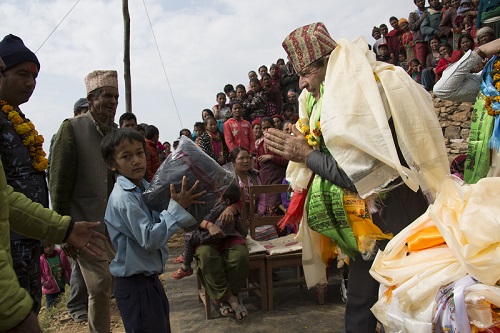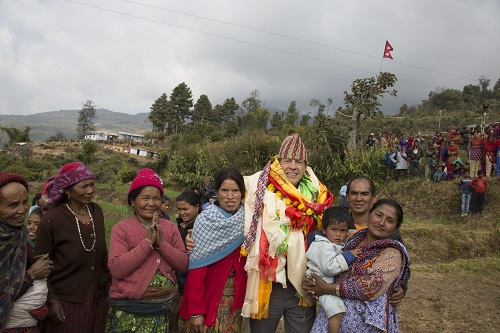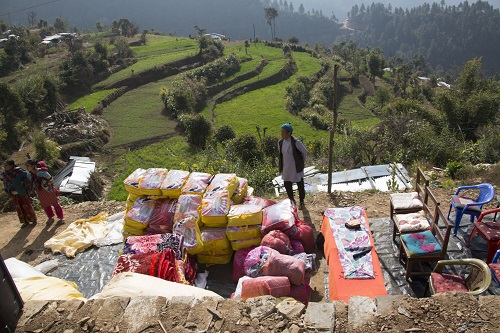A Special Message From our Founder
D. Gary Young

Eight months after the quake, 1.2 million people are still homeless and displaced, living in tents and makeshift lean-tos, tin sheds, or whatever they could put together to protect their families. Hundreds are dying from exposure and even starving to death in different villages.
Many villages still have not seen any help because the roads are gone, and the fields where they grew their crops are gone after four major quakes and over 114 tremors, followed by four months of heavy monsoons and fall rains in this mountainous area, where villages and small farms are nestled on the hillsides of the mountains with elevations from 8,000 to 14,000 feet. With the rain and unstable ground from the quakes and tremors, the landslides washed away homes that were not destroyed in the initial quake and took out water and irrigation systems, roads, homes, schools, and even hospitals.
If this was not enough, they went through a political government change from a kingdom monarchy to a republic constitutional government. Then the Indian government and Nepali Indian nationals started to riot, and the Indian Nationals blocked the roads at the border crossings, restricting food, fuel, and other necessary supplies from entering Nepal, additionally crippling the nation and jeopardizing people’s lives.
Although a lot of money had been donated, Mr. Binod Tamang was frustrated because there was still so much need, and the progress was seemingly very slow. He asked me if I could come to Nepal to offer any help. With all that I have to do, I wondered whether I could put one more thing on my plate, but I felt a wave of compassion envelope me and knew that I had to go, I had to help.

We first went to Yarsa in the 6th district, the epicenter of the quake, a 7-hour drive from Katmandu, since the road to their village was still drivable. However, when we arrived, I was quite disturbed to learn that still, nine months later, no one had been to investigate the fate of 280 people and the loss of all their homes. We were the first to bring help with a semi load of blankets, coats, sweaters, hats, and pajamas. Handing out the supplies to every member of the village was a very emotional and gut-wrenching experience. The week before I arrived, 24 people had died from exposure, and two children died while I was there handing out the blankets.
I visited three other villages in the epicenter to find the same story—no one had responded to their need for help. I was told that millions of dollars had been donated but was still sitting in the banks for a myriad of reasons: political, inefficiency, and lack of direction. Thousands of homes could have been built before the winter months came with freezing temperatures and blowing snow. More than half of the 1.2 million homeless people are children, and who is protecting them? All the answers were unacceptable to me.
It was easy for me to see what to do, so I started on my quest. I was able to meet with the vice president of Nepal and asked him what we needed to do that would allow us to start building homes. His reply was almost comical, except that the situation was much too serious to laugh. With a curious look in his eye, he said, “Hire a local engineer and architect and go to work.”
I met with a director of one of the local organizations that was collecting donations and asked her what more I could do to help. She told me how amazed she was at what we had accomplished in just a few short days. For some reason, she thought because I moved so fast that I could step into a place of directing activities to help. It just didn’t make sense to me. I began to get a different view of these huge organizations and the massive amounts of money they collect and the expenses they incur.

Now it is time for our foundation to get involved. Nikki and Brittany followed me to Nepal a week later and had the same experience I had. They were overwhelmed with the work they know has to be done and the immensity of the need of the people of this tiny country not well known to the world, and we want to bring as many of our members as possible to help us build homes and schools who have skills and desire to be a part of this historical event for Young Living.
At our farm in Ecuador, we have a brick making machine that I imported from South Africa. This machine makes bricks from dirt mixed with a small amount of cement. It is very easy to operate, seismic safe, and efficient; and the bricks are very inexpensive because of their composite ingredients. It was a simple decision. Let’s get one of these machines to Nepal.
So I made the call and put in the order, and the Young Living Foundation purchased a complete automated block factory from Johannesburg, South Africa, which will arrive in Kathmandu any day.
We will be setting up the factory and teaching the people how to manufacture interlocking blocks made from dirt and cement, similar to what we have in Ecuador. We will teach the people how to build their homes. Once they have the homes, schools, and other buildings rebuilt, they will then be able to sell the blocks to help create an income for the villagers. However, to begin with, we need help financially, since this was not in the budget and came as a surprise.
I am sending three people to Johannesburg for the initial training—the engineer, the architect, and the project manager. Once the factory is up and running, and blocks are stacked and ready for construction, we will go in and help reconstruct the first village and then move to the next.
When we are ready, I will be asking for volunteers who have some construction experience. We will also need good labors to work in the factory, to move blocks, and to provide just good, general help of all kinds, regardless of their skills. Also, I am inviting doctors, nurses, dentists, therapists, social workers, cooks, teachers, and child counselors for the hundreds of earthquake orphans.
This is my idea and I invite any and all of you to join me. Starting Thursday, February 18, at 12 noon, which is a Nepal national holiday, I am asking our 2 million members to join me and my family, Mary, Jacob, and Josef, in a 24-hour fast or to abstain from food for 24 hours. Remember that prayers are powerful, and this suffering little country needs a lot of help.
Fasting is one of the oldest laws of God in every religion for spiritual, emotional, personal, and wonderful health benefits, which have been well documented for years. This is an opportunity to be a part of Young Living history in the making, perhaps an opportunity that comes only once in a lifetime.

I juice every 2 hours or when I start feeling hungry. When fasting, it is important to drink 128 ounces of only purified or distilled water during the 24 hours. Do not drink tap or city water and no bottled water in plastic containers.
When you complete your fast Friday afternoon, start with a light vegetable soup as your first meal. Wait for 1 hour to make sure your digestive system is comfortable; then you could have a light meal, but wait until Saturday before eating a meat meal. This will give you the best results. Those who are comfortable with fasting know what to do.
I have been practicing and teaching fasting for over 43 years; it is the greatest modality for longevity and well-being.
If you have never fasted, this is an opportunity to have a wonderful experience. You will discover things you would not imagine such as an empowering lightness and an increase in your spiritual awareness; and naturally, the longer you fast, the greater the experience. If you feel a slight headache as your body starts to cleanse, just drink more fluids.
For those who choose not to fast, we hope you join us in prayer and giving.
Determine approximately how much you would save, which is probably $6 or $7 per family member per meal, and then donate that to the Nepal Children’s Home Project at the Young Living Foundation. This will enable us to fund the building of hundreds of homes, schools, and clinics.
Last week at the Winter Harvest, I had the honor of a member handing me $100. He said, “I do not know if I can fast, but I can donate.” This is the spirit of our Young Living members, who make it so special and wonderful, and I am proud of all of you.
We will be sending out the notice of when we will be in Nepal, so perhaps you can plan a trip to join us. Also, the Young Living Foundation will be sending out notices of the best airlines and times to travel and the things required to enter Nepal such as a visa, which you can get at the Kathmandu airport. Just make sure you have a passport photo with you. If you forget, they do have photo booths in the airport; it just takes a little longer.
All of the information will soon be forthcoming. We will list the villages and their locations where we will be building, the lodging, food, and other needs.
This is truly an opportunity to make a huge difference for millions of people as we join together worldwide in a cause greater than ourselves.
We will also be able to see one of the most spectacular sites in the world—Mount Everest and the majestic Himalayan Mountains. In addition, Nepal is home to many aromatic plants such as wintergreen, sandalwood, rose, lavender, melissa, and many that are yet unnamed, so I also plan to build a small distillery while we are there building homes.
This is what Young Living is about—changing the world one person at a time. However, this will allow us to change a nation—and everyone can be a part of that change.
Thank you,


